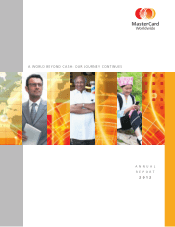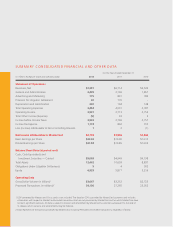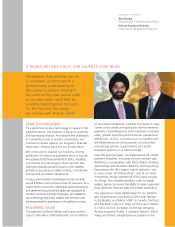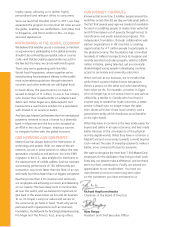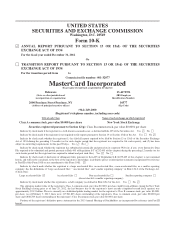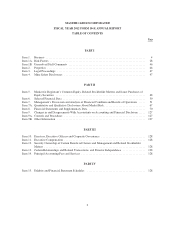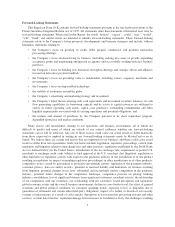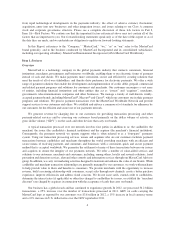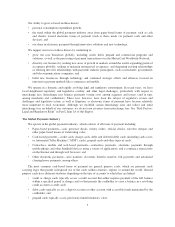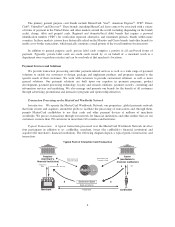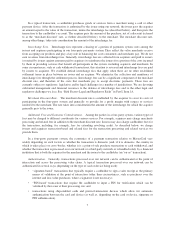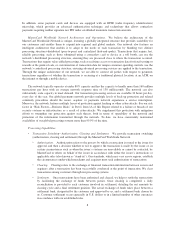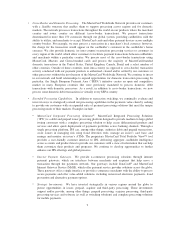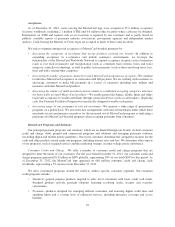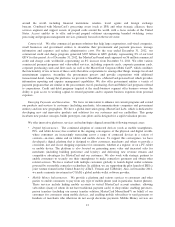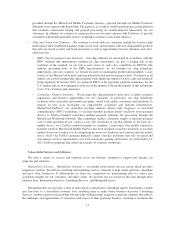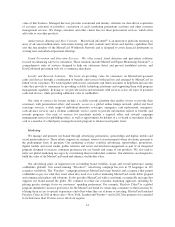MasterCard 2012 Annual Report Download - page 8
Download and view the complete annual report
Please find page 8 of the 2012 MasterCard annual report below. You can navigate through the pages in the report by either clicking on the pages listed below, or by using the keyword search tool below to find specific information within the annual report.from rapid technological developments in the payments industry; the effect of adverse currency fluctuation;
acquisition, entry into new businesses and other integration issues; and issues relating to our Class A common
stock and corporate governance structure. Please see a complete discussion of these risk factors in Part I,
Item 1A—Risk Factors. We caution you that the important factors referenced above may not contain all of the
factors that are important to you. Our forward-looking statements speak only as of the date of this report or as of
the date they are made, and we undertake no obligation to update our forward-looking statements.
In this Report, references to the “Company,” “MasterCard,” “we,” “us” or “our” refer to the MasterCard
brand generally, and to the business conducted by MasterCard Incorporated and its consolidated subsidiaries,
including our operating subsidiary, MasterCard International Incorporated (d/b/a MasterCard Worldwide).
Item 1. Business
Overview
MasterCard is a technology company in the global payments industry that connects consumers, financial
institutions, merchants, governments and businesses worldwide, enabling them to use electronic forms of payment
instead of cash and checks. We make payments more convenient, secure and efficient by creating solutions that
meet the needs of all of our stakeholders, and thereby drive preference for electronic payments. We offer a wide
range of payment solutions that enable the development and implementation of credit, debit, prepaid, commercial
and related payment programs and solutions for consumers and merchants. Our customers encompass a vast array
of entities, including financial institutions and other entities that act as “issuers” and “acquirers”, merchants,
governments, telecommunications companies and other businesses. We manage a family of well-known, widely-
accepted payment brands, including MasterCard®, Maestro®and Cirrus®, which our customers use in their payment
programs and solutions. We process payment transactions over the MasterCard Worldwide Network and provide
support services to our customers and others. We establish and enforce a common set of standards for adherence by
our customers for the efficient and secure use of our payments network.
We generate revenue by charging fees to our customers for providing transaction processing and other
payment-related services and by assessing our customers based primarily on the dollar volume of activity, or
gross dollar volume (“GDV”), on the cards and other devices that carry our brands.
A typical transaction processed over our network involves four parties in addition to us: the cardholder, the
merchant, the issuer (the cardholder’s financial institution) and the acquirer (the merchant’s financial institution).
Consequently, the payments network we operate supports what is often referred to as a “four-party” payments
system. Using our transaction processing services, issuers and acquirers who are our customers facilitate payment
transactions between cardholders and merchants throughout the world, providing merchants with an efficient and
secure means of receiving payment, and consumers and businesses with a convenient, quick and secure payment
method that is accepted worldwide. We guarantee the settlement of many of these transactions between our issuers
and acquirers to ensure the integrity of our payments network. We offer a number of value-added services and
solutions to our customers, merchants and consumers, including, among others, loyalty and rewards solutions, fraud
prevention and detection services, alert and other controls and information services through our MasterCard Advisors
group. In addition, we carry out marketing activities designed to maintain and enhance the value of our brands. While
cardholder and merchant transaction relationships are generally managed by our customers, we work with merchants
to help provide value to them and benefits to consumers. We provide merchants with the opportunity to increase
revenue, build a recurring relationship with consumers, accept sales through new channels, create a better purchase
experience, improve efficiencies and address fraud concerns. We do not issue cards, extend credit to cardholders,
determine the interest rates (if applicable) or other fees charged to cardholders by issuers, or establish the “merchant
discount” rate charged by acquirers in connection with the acceptance of cards that carry our brands.
Our business has a global reach and has continued to experience growth. In 2012, we processed 34.2 billion
transactions, a 25% increase over the number of transactions processed in 2011. GDV on cards carrying the
MasterCard logo as reported by our customers was $3.6 trillion in 2012, a 15% increase in local currency terms
and a 12% increase in U.S. dollar terms over the GDV reported in 2011.
4

